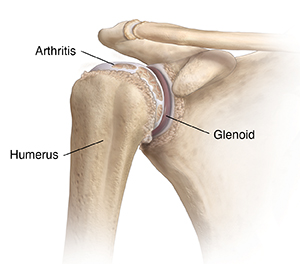Understanding Glenohumeral Osteoarthritis
A joint is where 2 or more bones meet. The glenohumeral joint is the main joint in the shoulder. It is a ball-and-socket joint. It is formed where the head or ball of the upper arm bone fits into the shallow socket on the shoulder blade. The upper arm bone is called the humerus. The socket is called the glenoid. This is how the joint gets its name. When the glenohumeral joint is healthy, it helps you rotate and move your arm freely without any pain.
With glenohumeral osteoarthritis, the parts of the joint wear down. This can cause pain, stiffness, and limited movement. Glenohumeral osteoarthritis is a long-term condition. But treatment can help manage symptoms, increase movement, and improve function.

How glenohumeral osteoarthritis occurs
All joints contain a smooth tissue called cartilage. Cartilage cushions the ends of bones. This helps them glide smoothly against each other. Glenohumeral osteoarthritis occurs when cartilage in the glenohumeral joint starts to break down. The ball and socket bones may then become exposed and rub together. The bones may become rough and pitted. They may start to wear away. This prevents smooth movement of the joint.
Causes of glenohumeral osteoarthritis
In most cases, the condition occurs because of damage from a past shoulder injury such as a dislocation, break (fracture), or rotator cuff tear. It can also occur after an infection in the joint. Normal wear and tear of the joint from aging can also cause osteoarthritis.
Symptoms of glenohumeral osteoarthritis
Symptoms tend to develop slowly over months to years. Shoulder pain is common. The pain is often worse with activity, and may get better with rest. Over time, the pain may get worse. It may even occur at night.
Stiffness in the shoulder is also common. It may be hard to move or use the arm and shoulder as you normally would. This can make it hard to do even simple tasks, such as reaching for an item on a shelf or getting dressed.
Treating glenohumeral osteoarthritis
Treatment may include:
-
Resting the shoulder. This includes limiting certain movements, such as reaching, lifting, pushing, or pulling. These can cause more wear and tear of the joint and make symptoms worse.
-
Cold or heat packs. Cold packs can help ease pain and swelling. Heat packs don't help with swelling. But they may help ease pain and stiffness, especially before physical therapy or activity.
-
Pain medicines. These help ease pain and swelling. Medicines may be prescribed or bought over the counter.
-
Shots (injections) of medicine into the joint. These may help ease symptoms for a time.
-
Physical therapy and exercises. These help improve strength and range of motion in the joint. This may reduce shoulder stiffness and improve function.
-
Certain assistive devices. These are tools that can be used to make activities of daily life easier. For instance, a device called a reacher can help you reach and grab items.
-
Alternative treatments. These include treatments such as acupuncture or massage. They may help ease pain and stiffness in some cases.
If other treatments don’t do enough to ease symptoms, you may need surgery. There are several types of surgery:
When to call your healthcare provider
Call your healthcare provider right away if you have any of these:
-
Fever of 100.4°F (38°C) or higher, or as advised by your provider
-
Symptoms that don’t get better with treatment, or that get worse
-
New symptoms